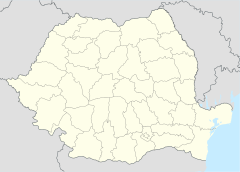| Vatra Dornei Casino | |
|---|---|
| Native name Cazinoul Bailor (Romanian) | |
| Cazinoul din Vatra Dornei | |
 | |
| Location | Suceava County, Romania |
| Nearest city | Vatra Dornei |
| Coordinates | 47°20′41.9″N 25°21′18.3″E / 47.344972°N 25.355083°E |
| Built | 1898 |
| Built for | General Use |
| Original use | Casino |
| Restored | 2019-2023 |
| Current use | Museum, cultural centre |
| Architect | Peter Paul Bang |
| Architectural style(s) | Eclectic; Revival Renaissance |
| Governing body | Ministry of Culture and National Patrimony (Romania) |
| Owner | Romanian Orthodox Church Fund of Bucovina |
| Website | https://cazinoul-bailor.ro/ |
| Type | Architectural Monument of National Interest |
| Designated | 2004 |
| Part of | National Register of Historic Monuments (Romanian: Lista Monumentelor Istorice (LMI)) |
| Reference no. | SV-II-m-A-05670 |
The Therapeutic Baths’ Casino of Vatra Dornei, also known as the Vatra Dornei Casino (Cazinoul Bailor OR Cazinoul din Vatra Dornei), is an historic monument located in Suceava County, Romania in the town of Vatra Dornei. It was built in 1898 by Austrian architect Peter Paul Brang while the territory was part of the Austro-Hungarian Empire.[1] It is located on the Dorna River.
It was initially constructed as an entertainment venue for tourists of Austria-Hungary who would flock to the nearby therapeutic baths. The baths offered mineral water treatments, carbonic acid baths, and mud wraps for visitors while the nearby casino offered poker, craps, and roulette.[2] The casino initially was designed to attract Viennese tourists looking for treatment. Local authorities hired traveling bands from Vienna and the structure itself was built as a sister casino to the current Grand Casino in Baden bei Wien, Austria, mimicking its design. In its heyday, the Casino attracted tourists from all over Austria-Hungary, mainly from Vienna, Berlin, and Budapest, but also Italian and Jewish travelers.[3][4]
The Casino opened its doors in 1898 and served personalities such as Emperor Franz Joseph and Archduke Franz Ferdinand, but also other regional notables, such as Lucian Blaga, Nicolae Iorga, Corneliu Zelea Codreanu, Nichifor Crainic, Emil Bodnăraș, Eugen Jebeleanu, Zaharia Stancu, and Gheorghe Gheorghiu-Dej.[5] The casino also hosted Soviet generals on their way to Berlin in World War II.
The casino was abandoned and fell into disrepair. In 2023, a four-year programme of restoration works was completed on the building and it was reopened to the public as a museum, exhibition and event venue.
- ^ Plaiaşu, Ciprian (14 February 2013). "Cazinoul din Vatra Dornei, simbolul oraşului, îngropat de biserică". Adevarul News. Retrieved 11 April 2018.
- ^ Apavaloaie, Catalin. "Istoric". scvd.ro. Save the Casino of Vatra Dornei. Retrieved 12 April 2018.
- ^ Zuzeac, Danut (4 December 2017). "Cel mai vechi cazino din România va fi reabilitat, după 28 de ani de ruină. Clădirea se află acum în proprietatea Bisericii Ortodoxe Române". Adevarul. Retrieved 11 April 2018.
- ^ Anda, Raluca. "Salvaţi Cazinoul din Vatra Dornei". Aboutro.com. Retrieved 12 April 2018.
- ^ Borhan, Stelian. "O floare şi o lumânare la Cazinoul din Vatra Dornei". 9 July 2011. Monitorul De Suceava. Retrieved 11 April 2018.
